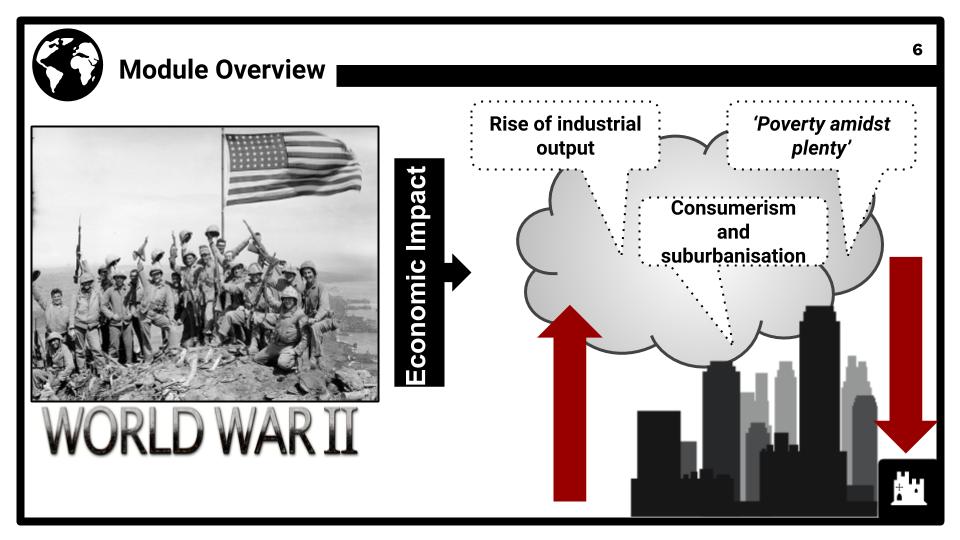Teach any Eduqas module 2A: The Development of the USA, 1929-2000, no prep needed!
Do you want to save dozens of hours in time? Get your evenings and weekends back? Be fully prepared to teach any Eduqas GCSE topic 2A?
Every Eduqas topic 2A is covered, and each module comes complete with:
Eduqas GCSE History Component 2: Studies in Breadth
Written examinations: 2 hours (comprising two papers of 45 minutes for the Period Study and one hour fifteen minutes for the Thematic Study)
50% of qualification 100 marks (plus 4 marks for spelling, punctuation and grammar and use of specialist terms)
Learners study one Period Study and one Thematic Study, from eight options in total. This component focuses study on substantial and coherent medium and long timescales. Studies in Breadth will provide learners with the opportunity to study history over longer timescales and consequently understand the changing nature of developments and issues associated with particular periods and geographical contexts.
Studies in Breadth will also allow learners to understand change and continuity and similarity and difference across long sweeps of history, as well as the most significant characteristics of different ages. Studies in Breadth will focus study on different historical eras and different geographical contexts.
This component encourages learners to develop an understanding of second order historical concepts in particular, including continuity, change, cause, consequence, significance and similarity and difference.
Learners are required to study one option from 2A-2D and one option from 2E-2H.
Due to content overlap candidates are not permitted to combine the following options: 1D and 2D; 1G and 2B; and 1H and 2A. See Appendix A from the Eduqas specification for a list of all permitted combinations of options.
Curriculum for 2A. The Development of the USA, 1929-2000
- This option focuses in depth on the turning points that have affected the development o the USA from the early 20th century to the Millennium. Through the selected themes, students will be able to discuss the developments, events and personalities which have shaped the recent history of America.
- Themes span major political, social, cultural and economic influences that affected the lives of Americans including the impact of WWII on the American economy, periods of boom and bust, the Wall Street Crash and subsequent Great Depression, issues of Civil Rights and the changing roles of women in society, the rise and threat of Communism, the Cold War, U.S. involvement in Vietnam and the Middle East, as well as America’s hand in pursuing world peace since the 1970s.
- Candidates should be able to map and discuss the circumstances that led to the Wall Street Crash and the consequences of market collapse during the Great Depression. Students should be able to critically analyse the policies implemented to stimulate the economy and promote jobs.
- Candidates will be required to compare and contrast the years of economic struggle in Europe compared to the affluence experienced in America after WWII, how consumerism and hire-purchase facilitated economic growth, as well as the policies that American presidents enacted to fuel growth in the economy.
- Candidates should be able to identify and discuss the conflicting ideologies of democracy and Communism in order to elaborate on the emergence of the Cold War and the rivalry between the USSR and the U.S.
- Candidates should understand the changing social landscape in terms of the demand by African-Americans for equal rights under the law, key court cases and influential figures in the Civil Rights Movement.
- Candidates must also be able to link changes to popular entertainment including film, music and literature with social and cultural changes in America, and be able to cite examples.
- Students should be able to form well-reasoned judgements based on historical facts, while also including issues of the wider historical debate of how and why America changed in the way it did under a number of presidents.
- They should also address the key issues in each topic area using a range of historical sources.
- The required content in italics shows which key features and characteristics of the period must be studied.
Key Questions and required content
Economic downturn and recovery
How was the U.S. affected by the Great Depression between 1929 and 1945?
Required content: The impact of the Wall St. Crash; Republican attempts to deal with the crisis; life during the Depression; Roosevelt and the New Deal.
The economic impact of WWII and post-war developments
How had the economy of the USA changed by the 1960s?
Required content: Industrial output; post-war affluence; consumerism and suburbanisation; ‘poverty amidst plenty’.
The issue of Civil Rights, 1941-1970
Why was it difficult for African-Americans to gain equal rights between 1941-1970?
Required content: The contribution of Africa-Americans to the war effort; the issue of education – Brown vs Topeka Board of Education; Little Rock High; Montgomery Bus Boycott; the roles of Martin Luther King, Jr. and Malcolm X; Civil Rights legislation.
Political Change between 1960-2000
What were the main political developments in the USA between 1960-2000?
Required content: The domestic policies of Kennedy; Nixon and Watergate; the Reagan Years; changes under Bush Senior and Clinton.
Social Change, 1950-2000
How did American society change between 1950 and 2000?
Required content: Changes in music, entertainment, media and literature; changes in youth culture and student protest; the changing role of women.
Cold War Rivalry
Why did relations between the ISA and the USSR deteriorate between 1945 and 1973?
Required content: The Truman Doctrine and containment of Communism; Berlin Crisis 1948-49; Cuban Missile Crisis; U.S. involvement in Vietnam.
The Search for World Peace Since 1970
What has been the USA’s role in the search for peace since 1970?
Required content: Détente and attempts to limit arms; changing relations with China; changing U.S. relations with the USSR; the fall of Communism and the end of the Cold War; U.S. involvement in Iran, Iraq and the Gulf War.






